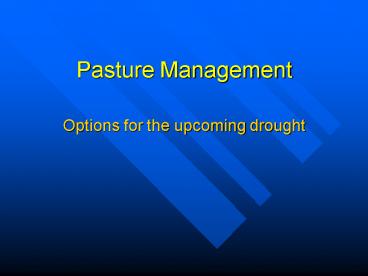Pasture Management - PowerPoint PPT Presentation
1 / 25
Title:
Pasture Management
Description:
Typically wet springs. hard to plant. time to make bermuda. Dry to very dry late July and August. ... wet spring. drought following. NWS predicts till Nov. ... – PowerPoint PPT presentation
Number of Views:328
Avg rating:3.0/5.0
Title: Pasture Management
1
Pasture Management
- Options for the upcoming drought
2
Typical Rainfall Patterns in Lamar County
- Typically wet springs
- hard to plant
- time to make bermuda
- Dry to very dry late July and August.
- low quality
- low quantity
- Wet October November
- time to make winter pasture
3
Predicted Weather
- 1999 Rainfall
- wet spring
- drought following
- NWS predicts till Nov.
- lower than normal rain
- higher than normal temperatures
- Extension Coordinator
- Travis Miller
- College Station
- Local Variation
- Producer decisions
4
Bermudagrass and Ryegrass Growth Curve
5
Producer Options
- Stay the course
- gamble that rain comes close to normal
- Change plans
- gamble that rain doesnt come
- Sell out
- gamble you keep some of the money
- Gambling anyway
6
Change plans
- Water Harvesting
- increase water storage
- decrease water loss
- increase use efficiency
- Increase available forage
- decrease stocking rate
- increase pasture acres
- grazing vs hay
- rent
- enhance forage growth
7
Water Storage
- Soil
- Seasonal storage
- Texture
- loamy best
- Infiltration
- Ground cover
- Water travel zones
- Rooting Zone
- Traffic pan
- Subsoil acidity
- Fertility stratification
8
Traffic Pans
- Compression of fine soil particles into the pore
space between large particles. - Limits water infiltration and root growth
- Occurs on wet soils
- Equipment movement
- Cattle Treading
9
Equipment Pans
- Location
- varies
- change in soil texture
- not all soils are susceptible
- Thickness
- usually thin
- Time
- short term
- thin pans
- long term
- Structure destruction
10
Treading
- Location
- usually in upper 4
- change in soil texture
- most visible in clay soils
- all soils susceptible
- Site exposure to animals
- short term
- Thin pans
- long term
- Rough field
- Structure destruction
- Long Term Solution
- protect susceptible sites
- manage for dense sods
11
Soil Pans
- Point in Time event
- Combination
- soil
- water
- traffic
- Problem Determination
- metal wire
- shovel
- Treatments
- varied
12
Treatments
- Prevention
- protect susceptible sites
- competitive sward
- Soil Regeneration
- soil type
- rooting activity
- fauna activity
- mid to long term solution
- Mechanical
- depth determinant
- short term solution
13
Mechanical
- Break the traffic pan
- Reforms under moist conditions and traffic
- Shattering vs. slicing
- Root damage
- Timing is critical
- Proper moisture
- Late Winter/early spring
14
Depth Treatments
- Dormant sod
- Dec.- early March
- Shallow
- 0-3
- Disk Harrow
- Moderate
- 3-6
- Spike type aerator
- Deep
- 6
- Chisel
15
Deep chiseling
- Horsepower hog
- 35-50 hp/shank
- Drier soils get better breakage but require
greater horsepower - Options
- bigger tractor
- smaller chisel
- Cost
- Paratill 8000
- used single shank??
16
Subsoil Acidity/Fertility Stratification
- Root growth limited by soil chemistry
- Acidity
- hostile pH (
- plant specific
- nutrient uptake efficiency
- solution
- soluble Ca source
- Stratification
- subsoil mining
- limited nutrient movement
- solution
- soluble nutrients
- soil mixing
17
Liebergs Law of Limits
- Crop yield
- barrel water
- Yield limitations
- shortest stave
- 2000 water
- fertilize to match water limitations
- over fertilize lost
- under fertilize lost yield
- proper fertilizer matches water limitation
18
Coastal yield, CP and water use as affected by
Nitrogen Rate
19
Influence of Nitrogen and Potassium on Coastal
Bermudagrass Survival
20
Nutrient removed (lbs./ac) by grazing and hay.
21
Why control weeds?
22
Plant Establishmentand Persistence
- Seed germination requirements
- Stratification
- Moisture
- seed/soil contact
- Infrared light
- Nutrient Reserve is key to persistence
- The older the plant is and the more storage
(reproductive) organs the plant has the greater
the nutrient reserve and the harder it is to
control.
23
Weed Control Methods
- Mechanical
- mowing
- cultivation
- Biological
- mulch
- grazing
- Crop Rotation
- Fire
- Crop Competition
- Chemical
24
Labeled Herbicides
- Broadleaf
- 2,4-D annual
- Banvel
- Weedmaster
- Picloram
- Grazon PD
- Sulfanyl Urea
- Ally, Amber
- specific weed tolerance and susceptibility
- Rave Amber Banvel
- Grasses
- Roundup
- Gramoxone
- Amber
- some annual grass
- Ally
- bahiagrass
- Velpar
- smutgrass
25
Basic Principles of Chemical Weed Control
- Know your weeds
- Choose the right herbicide
- Calibrate your sprayer
- Spray at the proper time
26
Summary
- Culling time again
- Decisions to be made
- Moisture
- determine limitations and options
- increase moisture reserves
- manage accordingly
- Forage availability
- reduce stocking rate
- increase acreage
- increase efficiency
- weed control
- fertilization































